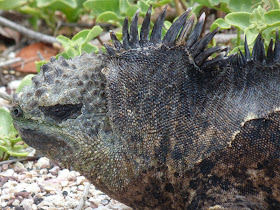As I said yesterday, true horns are nearly exclusively the province of the cattle/antelope/goat family, but many other animals - especially in the same big hoofed Order of Artiodactyls - have developed sharp things on their heads for poking other animals, or least to threaten to do so.
Probably the best-known of these are the deer (Family Cervidae); these are very familiar to many of the northern hemisphere readers of this blog, though in most parts of Australia deer are non-numerous invasive animals. (In some areas here however they are definitely a looming environmental problem.) In all deer species but Reindeer, only the males have antlers. Like true horns the mature antlers are formed of bone, but there are some important differences. The antlers grow every year and are shed at the end of the mating season; each year the antlers are larger and more complex that the previous year's growths. Moreover each year the antlers are relatively larger compared with the stag's body size, so that a bull Moose (Alces alces) may have antlers weighing 30kg and with a span of two metres. This is a hugely demanding process, both to grow and to carry them. While growing, antlers are covered in skin called 'velvet'; unlike the keratin covering of horns, this velvet is covered with hair and is full of blood vessels and nerve fibres, and is very sensitive to the touch. After some five months the bone hardens and 'dies' and the velvet dries and is shed.
Hormones spark the growth of the antlers each year; as the hormones recede at the end of the season, a layer of cells grows through the base of the antler, weakening the bone so that it eventually drops.
Giraffe (Giraffa camelopardalis) horns are not sharp, but they are certainly functional. Unlike antlers they are simple and permanent and borne by both sexes, though like antlers they are covered in skin and hair. They comprise bony cartilage and are technically known as ossicones. Males use them as formidable weapons, using the full length of the neck to swing the horned head as a potentially lethal club, especially in combat with rival males.
 |
| Giraffe ossicones, Etosha National Park, Namibia. |
Another well-known bearer of horns is the rhino - or rather the five living species of rhinoceros, which belong, along with tapirs and horses, to the much smaller Order Perissodactyla, the odd-toed ungulates. Their horn differs from other structures we've discussed in having no bony core; rather it consists of fused keratin fibres, attached to a roughened area of bone on the skull. The two African species and the Sumatran Rhino have two such horns; the other two Asian species have only one.
 |
| White Rhinoceros (Ceratotherium simum) female and calf, Mkuze Game Reserve, South Africa. |
Tusks are another version of pointy tools or weapons on heads, but they are greatly extended teeth. Probably our first thought with regard to tusks is of elephants, whose tusks comprise elongated incisors; in the African species both sexes have them, while in Asian Elephants they are mostly limited to males.
 |
| African Savanna Elephant (Loxodonta africa), Queen Elizabeth National Park, Uganda. |
Pigs also often bear tusks, though theirs are enlarged canine teeth. They are used for digging up tubers and other food, as well as formidable weapons of defence.
 |
| Warthog (Phacochoerus africanus), Queen Elizabeth National Park, Uganda. |
In entirely different Orders of mammals, other tusk-bearers are Walrus (Odobenus rosmarus), the sole member of a family related to seals and sea-lions, whose tusks are also canines, and the toothed whale called the Narwhal (Monodon monoceros) whose tusk comprises just one elongated straight canine.
And it may be drawing a longish bow, but even some reptiles have spiked heads, though in their case the 'horns', or spines, consist of modified scales - keratin, like the rhino's.
 |
| Marine Iguana (Amblyrhynchus cristatus), Galapagos. |
 |
| Central Bearded Dragon, (Pogona vitticeps), Family Agamidae; south-west Queensland. |
And I think with that we're pretty much horned out, and it's time to think of something a bit smoother tomorrow.

While in Sri Lanka we saw the Rhinoceros Lizard with a single horn, very like the mammal after which it is named. As you suggest for reptiles, the 'horn' is a modified scale.
ReplyDeleteMartin
Thanks, that would have been an excellent candidate for the post, but I wasn't aware of it until now. But I now am, for which I am grateful!
ReplyDelete